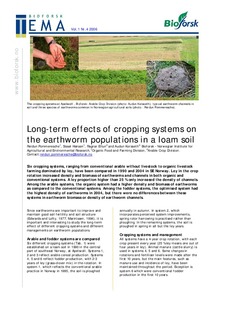| dc.contributor.author | Pommeresche, Reidun | |
| dc.contributor.author | Hansen, Sissel | |
| dc.contributor.author | Eltun, Ragnar | |
| dc.contributor.author | Korsæth, Audun | |
| dc.date.accessioned | 2018-07-14T13:48:59Z | |
| dc.date.available | 2018-07-14T13:48:59Z | |
| dc.date.created | 2018-06-29T13:17:25Z | |
| dc.date.issued | 2006 | |
| dc.identifier.isbn | 978-82-17-00028-0 | |
| dc.identifier.issn | 0809-8654 | |
| dc.identifier.uri | http://hdl.handle.net/11250/2505457 | |
| dc.description.abstract | Six cropping systems, ranging from conventional arable without livestock to organic livestock farming dominated by ley, have been compared in 1990 and 2004 in SE Norway. Ley in the crop rotation increased density and biomass of earthworms and channels in both organic and conventional systems. A ley proportion higher than 25 % only increased the density of channels. Among the arable systems, the organic system had a higher density and biomass of earthworms as compared to the conventional systems. Among the fodder systems, the optimised system had the highest density of earthworms in 2004, but there were no differences between these systems in earthworm biomass or density of earthworm channels. | nb_NO |
| dc.description.abstract | Long-term effects of cropping systems on the earthworm populations in a loam soil | nb_NO |
| dc.language.iso | eng | nb_NO |
| dc.publisher | Bioforsk | nb_NO |
| dc.relation.ispartof | Bioforsk TEMA | |
| dc.relation.ispartofseries | Bioforsk TEMA;1(4) 2006 | |
| dc.title | Long-term effects of cropping systems on the earthworm populations in a loam soil | nb_NO |
| dc.type | Research report | nb_NO |
| dc.description.version | publishedVersion | nb_NO |
| dc.source.pagenumber | 4 | nb_NO |
| dc.source.volume | 1 | nb_NO |
| dc.source.issue | 4 | nb_NO |
| dc.identifier.cristin | 1594764 | |
| cristin.ispublished | true | |
| cristin.fulltext | original | |
